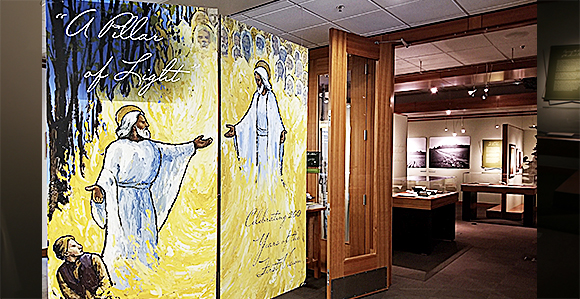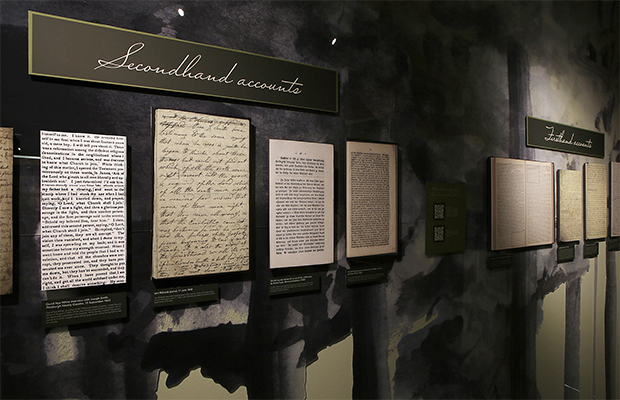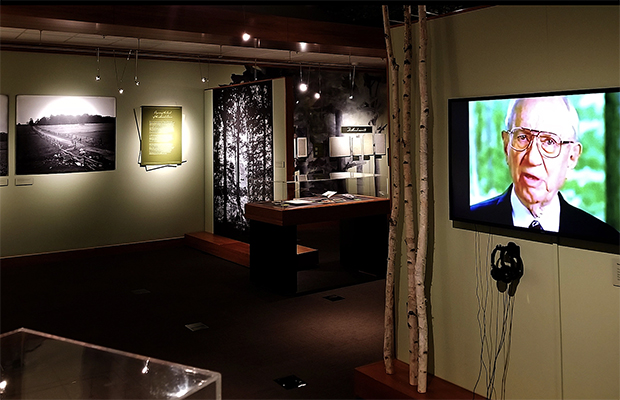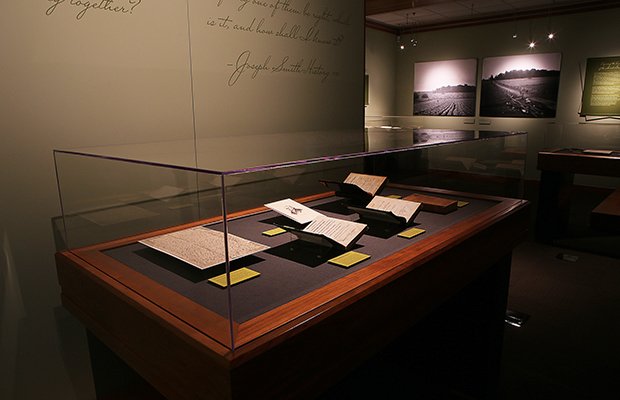Multimedia Exhibit at BYU Commemorates 200th Anniversary of the First Vision
Contributed By Jason Swensen, Church News staff writer

The exhibition “A Pillar of Light” at BYU’s Harold B. Library commemorates the upcoming 200th anniversary of the First Vision. Photo by BYU Photo.
Article Highlights
- The “Pillar of Light” exhibition is both educational and inspirational as it guides viewers through Joseph Smith’s experience in the Sacred Grove.
“Just like Joseph, no matter how dark and foreboding the enemy may be, we can continue to call out and we will be heard.” —Gerrit van Dyk, curator
Related Links
PROVO, Utah
For Latter-day Saints and many others, the upcoming bicentennial of young Joseph Smith’s First Vision is, at once, an opportunity to ponder a cosmic and pivotal moment of history while also exploring one’s own connection to the divine.
The 14-year-old boy’s 1820 theophany in the Sacred Grove marked both the opening lines of the Restoration and an era of prophetic revelation that continues today’s through Joseph’s successor President Russell M. Nelson.
But the First Vision also remains perhaps the quintessential reminder that mortals can still communicate with Heavenly Father and His Son, Jesus Christ.
An ongoing exhibition at BYU’s Harold B. Lee Library entitled “A Pillar of Light: Celebrating 200 Years of the First Vision” celebrates both the historic and deeply personal aspects of that defining event.
Located on the library’s first level in the L. Tom Perry Special Collection section, the exhibition explores the First Vision’s essential place in American religious history.
Galleries include early photographs of New York’s Sacred Grove, rare documents and books from the library’s collection, an infographic of First Vision mentions in general conference, and an original work of art entitled “First Visions” by BYU professor and artist Tony Sweat. His painting functions as a focal point of the exhibit.
Exhibition patrons who may never visit Palmyra can still “feel” the ambience of the Sacred Grove. The placid sounds of chirping birds and soft breezes allow imaginative visitors to be with Joseph Smith as he prays for clarity and direction.
One of the central goals of the exhibition was to provide patrons with the historical aspects of the First Vision while simultaneously connecting them on a personal level to that monumental event.
“We hope it will be both educational and inspirational,” said Ryan Lee, curator of the collection’s 19th century manuscripts.
Lee’s fellow curator, Gerrit van Dyk, said people today—just like young Joseph—often feel disconnected. They too want to know where they belong and where to find meaning in their lives.
That makes an exhibition like “A Pillar of Light” and the event it commemorates “more relevant than maybe ever before,” he said.
The exhibition has been in the works for five years. Curators recognized the importance of the First Vision anniversary and wanted to get it right.
“We’re always looking for significant events that we can commemorate in some way, and this was one of the big ones. We knew we had to do something,” said Lee.
Van Dyk said the exhibition offers visitors a walk through time. It begins with a section on American religious history to contextualize Joseph Smith’s confusion about the theological questions of the day.
A subsequent section includes all nine accounts of the First Vision.

All nine accounts of the First Vision are included in the BYU exhibition “A Pillar of Light.” Photo by BYU Photo.
“That was something that was really important to us,” said van Dyk. “We wanted to have everything that had come from Joseph … displayed in succession so visitors can compare them and think about them.”
“A Pillar of Light” also includes a section highlighting the centennial of the First Vision that includes a journal from Elder James E. Talmage and historical photographs of the Sacred Groves, along with memorabilia from the celebrations.
Sections also highlight how scholars have engaged with the First Vision, be they critics or believers.
Paintings, sheet music, poetry, and even a couple panels of comic book art demonstrate the many ways people have interpreted and internalized the events surrounding Joseph’s experience in the grove.
The last section “primes the pump” for departing visitors to ask: “What does the First Vision mean to me?”
Curators hope the exhibition is viewed by folks of all ages and religious backgrounds. The First Vision is a reminder that each individual matters.
“And just like Joseph, no matter how dark and foreboding the enemy may be, we can continue to call out and we will be heard,” said van Dyk.
Lee added his hopes that visitors find a space that promotes peace and quiet reflection.
Admission to “A Pillar of Light” is free. The exhibition will run through June of 2020. For those who can’t make it to Provo, a website has been set up to supplement the exhibition at exhibits.lib.byu.edu/first-vision/.

The “Pillar of Light” exhibition at BYU includes several multimedia elements that allow visitors to gain new understandings of the First Vision. Photo by BYU Photo.

Books and manuscripts from BYU’s Harold B. Library enrich the ongoing exhibition “A Pillar of Light.” Photo by BYU Photo.

The “Pillar of Light” exhibition at BYU includes books, manuscripts, historic photos, and contemporary media to tell the essential story of Joseph Smith’s First Vision in 1820. Photo by BYU Photo.
